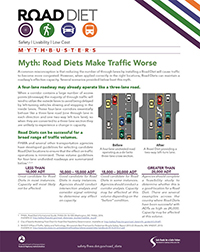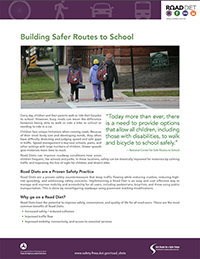August 11, 2016
Innovation of the Month: Road Diets
Road diets have been used to enhance safety and mobility in the United States for more than three decades. They’re becoming more popular as highway agencies and communities recognize their benefits:
- Safety—Studies show a 19 to 47 percent decline in crashes when a road diet is installed on a four-lane undivided road. They also make room for pedestrian refuge islands in the midblock crossing area, where 70 percent of pedestrian fatalities occur.
- Low cost—The majority of road diets are installed on existing pavement within the right-of-way, essentially for the cost of restriping pavement lanes.
- Quality of life—Road diets can make shared spaces more livable and contribute to a community-focused environment.
See the FHWA Road Diets webpage for roadway reconfiguration resources, including the Building Safer Routes to School brochure on how road diets can enhance safety near schools and the Road Diet Myth Busters flyer debunking the myth that road diets reduce traffic capacity.
Read Road Diet Informational Guide for details on a decision-making process to determine if road diets are a good fit for a corridor.
Nation's First Innovation Showcase Recognizes Pennsylvania
U.S. Deputy Transportation Secretary Victor Mendez and Federal Highway Administrator Gregory Nadeau joined Pennsylvania officials at an Innovation Showcase and roundtable discussion on August 4. They recognized Pennsylvania’s State Transportation Innovation Council as a national model in using state-of-the-art technologies on highway projects. Many of the innovations the STIC has helped foster in Pennsylvania were promoted by the Every Day Counts initiative, including adaptive signal control technology, high-friction surface treatments, warm-mix asphalt, accelerated bridge construction and the Safety Edge paving technique.
 Gregory Nadeau (left) and Victor Mendez (center) view exhibits at the Pennsylvania Innovation Showcase in Harrisburg. Credit: Pennsylvania Department of Transportation
Gregory Nadeau (left) and Victor Mendez (center) view exhibits at the Pennsylvania Innovation Showcase in Harrisburg. Credit: Pennsylvania Department of Transportation
Arkansas and Nebraska Share e-Construction Lessons
Arkansas State Highway and Transportation Department staff discussed e-Construction deployment at a peer exchange with the Nebraska Department of Roads on July 26 and 27 in Little Rock. Arkansas staff described how using document tracking software is shortening processes for evaluating bids and approving contract modifications, resulting in more efficient project delivery. The Nebraska agency plans to use insights from the exchange as it incorporates its project delivery processes in a statewide document management database system.
Florida Offers Local Agency Project Training
FHWA is wrapping up an 18-month statewide training program for local agency, private sector and Florida Department of Transportation staff on the Local Agency Checklist for Federally Funded Professional Services Contracts. By the time the training ends in September, more than 400 people will have participated in workshops on drafting documents for consultant planning, study, design and construction engineering inspection phases on projects. The purpose of the training is to ensure compliance on locally administered Federal-Aid projects.
Ohio Conference Focuses on Transportation Planning
Emerging trends and new tools for transportation planning were on the agenda at the Ohio Planning Conference on July 26 and 27 in Columbus. Ohio is one of the states participating in the EDC-3 effort on regional models of cooperation, which helps agencies and stakeholders work together on transportation planning. The Ohio Department of Transportation and American Council of Engineering Companies of Ohio sponsored the conference.
See New Work Zone Safety Report
A new FHWA report—Development and Application of Work Zone Crash Modification Factors— presents a methodology for estimating the safety impacts of highway work zones. Crash modification factors provide the expected change in crash frequency when a safety countermeasure is used. The report can help agencies implementing data-driven safety analysis use crash modification factors to choose work zone countermeasures and schedule lane closures.




